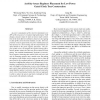ACSC
2003
IEEE
14 years 8 months ago
2003
IEEE
This paper presents an innovative strategy to synchronize all virtual clocks in asynchronous Internet environments. Our model is based on the architecture of one reference clock a...
PODC
2004
ACM
14 years 8 months ago
2004
ACM
We introduce the distributed gradient clock synchronization problem. As in traditional distributed clock synchronization, we consider a network of nodes equipped with hardware clo...
ISLPED
2004
ACM
14 years 8 months ago
2004
ACM
This paper re-examines the well established clocking principles of pipelines. It is observed that clock gating techniques that have long been assumed optimal in reality produce a ...
GECCO
2005
Springer
14 years 8 months ago
2005
Springer
The clock signal and clock skew become more and more important for the circuit performance. Since there are salient shortcomings in the conventional topology construction algorith...
ISCAS
2005
IEEE
14 years 8 months ago
2005
IEEE
— Recently power becomes a significant issue in clock network design for high-performance ICs because the clock network consumes a large portion of the total power in the whole s...
ASYNC
2005
IEEE
14 years 8 months ago
2005
IEEE
We present an apparatus used to distribute a timing reference or clock across the extent of a digital system. Selftimed circuitry both generates and distributes a clock signal, wh...
ISLPED
2006
ACM
14 years 9 months ago
2006
ACM
—The thermal gradients existing in high-performance circuits may significantly affect their timing behavior, in particular, by increasing the skew of the clock net and/or alteri...
ICCAD
2006
IEEE
14 years 9 months ago
2006
IEEE
Abstract—Power/ground noise is a major source of VLSI circuit timing variations. This work aims to reduce clock network induced power noise by assigning different signal polariti...
DATE
2006
IEEE
14 years 9 months ago
2006
IEEE
—The clock distribution network is a key component of any synchronous VLSI design. High power dissipation and pressure volume temperature-induced variations in clock skew have st...
ISVLSI
2007
IEEE
14 years 9 months ago
2007
IEEE
As power consumption of the clock tree dominates over 40% of the total power in modern high performance VLSI designs, measures must be taken to keep it under control. One of the m...





